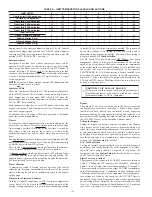
II.
COMPONENT LOCATION AND WIRING
CONSIDERATIONS
WARNING:
ELECTRICAL SHOCK HAZARD
Failure to follow this warning could result in personal
injury or death.
Turn off power to unit before routing control wiring or
any service operation. Remember, there may be more
than one power supply to unit.
All wiring must comply with national, local, and state codes.
A.
Locating Bryant 3-Zone System
All wiring is run back to the Bryant 3-Zone System. Select a
location near the furnace or fan coil where wiring from each
thermostat, each damper actuator, and the equipment itself can
come together easily.
The Bryant 3-Zone System is approved for indoor use only and
should never be installed with any of its components exposed to
the elements. It may be installed in any area where the temperature
remains between 32° and 158°F, and there is no condensation. The
cover must be installed to prevent damage from other sources. Do
not locate where it will be accessible to children. It may be
mounted in either vertical or horizontal position. Remember that
wiring access is likely the most important consideration.
CAUTION:
EQUIPMENT DAMAGE HAZARD
Failure to follow this caution may result in equipment
damage.
To prevent possible damage to Bryant 3-Zone System, do
not mount control on plenum, duct work, or flush against
furnace.
B.
Locating Thermostats
For proper operation, each thermostat must accurately measure the
temperature within its zone.
For accurate temperature measurement, the following guidelines
should be followed:
Thermostat should be mounted:
•
Approximately 5 ft. (1.5m) from floor.
•
Close to the center of its zone, preferably on an inside wall.
•
On a section of wall without pipes or duct work.
Thermostat should NOT be mounted:
•
Close to a window, on an outside wall, or next to a door leading
to the outside.
•
Where it will be exposed to direct light and heat from a lamp,
sun, fireplace, or other temperature radiating object which may
cause a false reading.
•
Close to or in direct airflow from supply registers and return-air
grilles.
•
In areas with poor air circulation, such as behind a door or in
an alcove.
C.
Wiring Considerations
All wiring in the Bryant Three-Zone system may be unshielded.
Ordinary thermostat wire is ideal. Use 22 gage or larger for normal
wiring. Lengths over 100 ft. should use 20 gage or larger wire.
Each damper actuator requires 3 conductors. The connection to
thermostats and equipment (furnace or fan coil) could require as
many as 8 conductors for a multi-stage installation. The leaving air
temperature (LAT) and heat pump temperature (HPT)—(used with
heat pumps only) sensors require 2 conductors each.
Cables with excess conductors are acceptable. Cut off or fold back
and tape any unneeded conductors.
Plan the routing of wiring early to avoid possible problems later
on.
Remember all wires converge at the Bryant 3-Zone system, so its
location is important.
III.
INSTALL COMPONENTS
A.
Install Bryant 3-Zone System
The Bryant 3-Zone System is designed so that wires can enter it
from behind, above, or below. Plan wire routing before mounting.
1. Open door to access eight mounting screw slots
2. Mount to wall using four screws and wall anchors provided.
3. Level and tighten screws.
B.
Install Thermostats
1. Follow manufacturer’s supplied instructions for installing
thermostats.
CAUTION:
EQUIPMENT DAMAGE HAZARD
Failure to follow this caution may result in equipment
damage.
Improper wiring or installation may damage the thermo-
stats. Check to make sure wiring is correct before
proceeding with installation or turning on unit.
IV.
INSTALL ZONE DAMPERS
Proper selection and sizing of dampers is important for proper
system operation. Selection and sizing information is not provided
in this installation instruction.
If duct work requires multiple dampers for a single zone, up to 5
dampers may be wired in parallel.
Zone dampers may be installed in any position.
Install dampers so that actuator is visible for inspection and
accessible in the event it would ever need to be serviced. The black
mark on the end of damper shaft represents position of damper
blade.
The 45 degree actuators on round ducts have their mechanical
stops set at 45 degrees. DO NOT CHANGE THIS SETTING.
Doing so will allow the actuator to close when it is trying to open.
If an actuator is removed, it must be properly aligned when it is
reinstalled. Do this by rotating the actuator and the blade to their
closed positions and then tightening the actuator to the shaft. This
assures alignment at the closed position. (Pressing the blade
release button releases the motor and allows the actuator to be
manually turned.)
CAUTION:
EQUIPMENT DAMAGE HAZARD
Failure to follow this caution may result in equipment
damage.
When dampers are located in an unconditioned space,
condensation is likely to occur in cooling. Regular and
severe condensation will damage the actuator. To prevent
condensation and losses, all dampers and ductwork in
unconditioned space must be insulated or otherwise
protected.
Whenever condensation might occur, it is recommended that
plastic actuator covers (Part# DAMPACTXXCOV) be used over
the actuator. These covers can help prevent condensation on
actuators by locking out ambient humidity. Insulation may be
applied over the cover to minimize heat transfer.
To install, place the cover over actuator and seal in place over the
surrounding insulation with duct tape on all four sides. Sealing
need not be perfect because there will be positive pressure inside
the cover. Do not mount the dampers with their actuators hanging
directly beneath the ductwork. It is best to mount the actuator
facing in either the three or nine o’clock position.
—2—
Summary of Contents for ZONEBB3Z
Page 11: ...11...






























